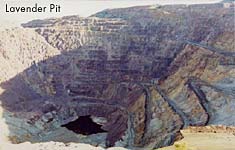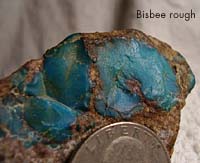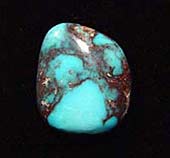Turquoise
occurs in relatively few areas in the world.
The Southwestern United States, Persia (Iran)
and China have been the most active producers.
Turquoise mining has never been marked by boom
towns and mining camps. It has usually been
carried out on a small scale by individual miners
or families and sometimes as a side operation
of copper mining. Below are listed some of the
more famous turquoise mines though only a few
are still active today. To read about others,
especially many of the older small producing
mines please check our book page.
 BISBEE
BISBEE
Bisbee turquoise it is a by-product of a large
copper mine located near Bisbee, Arizona owned
by Phelps Dodge Mining Company. With some of
the finest turquoise coming from the section
of the copper mine known as the "Lavender
Pit," where for years copper miners would
bring out fine turquoise in their lunch boxes.
In March of 1972 a miner named Bob Matthews
was given the only lease ever granted for rights
to mine Bisbee turquoise. He was said to have
recovered more than 2,000 pounds of good to
excellent turquoise by 1974. The Bisbee is considered
to be the first large open-pit copper mine in
Arizona. As the pit was extended quantities
of fine turquoise were recovered. The turquoise
occurred in stringers up to a few inches wide
along with small nugget-like masses in granite
and quartzite.
 Bisbee
turquoise is as good as turquoise gets. It is
a hard material with shades from medium to an
intense blue color and enhanced by a red, brown
or black, sometimes called "smoky,"
matrix. Green shades have also been found. Bisbee
turquoise was marketed very early in the Southwest
and that along with its quality help make it
one of the more famous varieties of American
turquoise. Sadly, Bisbee turquoise is no longer
being produced. With its extreme blue color
and beauty, hardness and now rarity Bisbee has
become one of the most valued turquoise in the
world today. Bisbee
turquoise is as good as turquoise gets. It is
a hard material with shades from medium to an
intense blue color and enhanced by a red, brown
or black, sometimes called "smoky,"
matrix. Green shades have also been found. Bisbee
turquoise was marketed very early in the Southwest
and that along with its quality help make it
one of the more famous varieties of American
turquoise. Sadly, Bisbee turquoise is no longer
being produced. With its extreme blue color
and beauty, hardness and now rarity Bisbee has
become one of the most valued turquoise in the
world today.
Bisbee's story is one of the great mining stories
of America. On December 14, 1877 three prospectors,
Hugh Jones, Joseph Halcro and Harry McCoy, after
discovering a copper stained outcropping of
rocks filed a claim on the first copper mine
in the area. By 1879 one hundred claims were
filed and a mining camp had begun informally
known as Mule Gulch. The original, and largest,
claim at that time was known as the Copper Queen
mine. Investments were needed and its search
for investors lead to Judge Dewitt Bisbee.
 Thus
in honor of the camp's major mine financier,
Judge Bisbee, the blossoming new town was named
Bisbee, With the camp's major mine now financed
and the mining camp's growth into a new town,
Bisbee was ready to become one of the most important
mining cities in America. In 1881 Phelps, Dodge,
and Co. purchased the Atlanta, next to the Copper
Queen, and in August 1885 a merger had brought
the two mines together. The railroad had come
to Bisbee in 1889 and by the mid to late 1890's
Phelps, Dodge, and Co. had now owned 90% of
the Copper Queen Consolidated Mining Co. and
had purchased most of the other mining properties
in the area. Copper was being produced in Bisbee
for decades. In the early 1950's work began
on Sacramento Hill, a large low-grade copper
ore pile. Harrison Lavender, the manager of
the Copper Queen, had determined an open pit
mine would increase ore yield. On December 14,
1974, twenty years later, mining had stopped
and the thousand foot deep Lavender Pit covering
300 acres had replaced the hill. The Lavender
Pit had become a tourist destination with rim
viewing platforms and guided tours. Thus
in honor of the camp's major mine financier,
Judge Bisbee, the blossoming new town was named
Bisbee, With the camp's major mine now financed
and the mining camp's growth into a new town,
Bisbee was ready to become one of the most important
mining cities in America. In 1881 Phelps, Dodge,
and Co. purchased the Atlanta, next to the Copper
Queen, and in August 1885 a merger had brought
the two mines together. The railroad had come
to Bisbee in 1889 and by the mid to late 1890's
Phelps, Dodge, and Co. had now owned 90% of
the Copper Queen Consolidated Mining Co. and
had purchased most of the other mining properties
in the area. Copper was being produced in Bisbee
for decades. In the early 1950's work began
on Sacramento Hill, a large low-grade copper
ore pile. Harrison Lavender, the manager of
the Copper Queen, had determined an open pit
mine would increase ore yield. On December 14,
1974, twenty years later, mining had stopped
and the thousand foot deep Lavender Pit covering
300 acres had replaced the hill. The Lavender
Pit had become a tourist destination with rim
viewing platforms and guided tours.
Today in and around Bisbee and under the Mule
Mountains are over 1500 miles of tunnels and
shafts along with the now famous Lavender Pit.
|